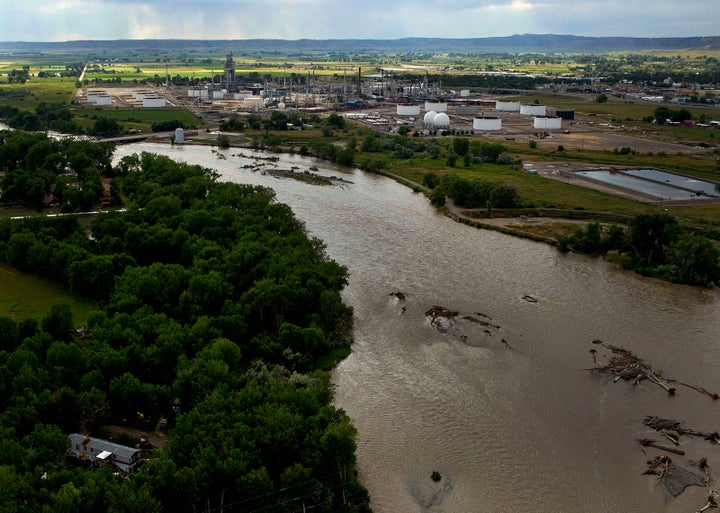
SALMON, Idaho (Reuters/Laura Zuckerman) - An Exxon Mobil pipeline that ruptured, leaking oil into Yellowstone River, may have sometimes carried a heavier and more toxic form of crude than initially thought, federal regulators said on Thursday.
The U.S. Transportation Department's Pipeline and Hazardous Materials Safety Administration spokeswoman Patricia Klinger said her office had learned that the pipeline may have been used to carry heavier crude.
"I just found out that apparently, and the regional folks just found out, there is an interconnect on the pipeline that possibly does carry some oil out of Canada," she said in response to a question about tar sands crude in the pipeline.
That a pipeline thought to transport only "sweet," low sulfur crude could have carried so-called tar sands crude from Canada raised concerns by health and environmental officials, even as Exxon officials said the heavier oil was not flowing through the Silvertip pipeline when it broke on July 1.
"The actual crude in the line at the point of the incident was a blend of crudes from Wyoming," Exxon spokesman George Pietrogallo told Reuters in an email on Thursday.
Exxon was responding to a question about whether tar sands crude had ever flowed in the pipeline. Almost all the oil produced in Canada's Alberta fields is from tar sands.
The chemistry of tar sands oil, derived from tar sands or bitumen and sweet crude is significantly different, said Ronald Kendall, head of the environmental toxicology department at Texas Tech University.
"Tar sands oil is in itself heavier oil and it contains more compounds that are toxic and may contain heavy metals like lead," Kendall said.
In a July 6 email to Reuters, Exxon spokesman Kevin Allexon said the crude carried by the pipeline "does not originate from Alberta" but from fields on the Montana-Wyoming border. On Thursday, Exxon revised that.
"The pipeline carries a variety of different production fields in the U.S. and Canada," Pietrogallo said in the email.
'HELL NO'
Tar sands crude may cause more wear and tear on pipes because of its chemical makeup, including corrosive and abrasive agents, said Tom Finch, the pipeline administration's technical services director for the western regional office.
Federal inspectors were trying to determine if transport of tar sands crude could have triggered internal corrosion that may have played a role in the rupture, he said.
Montana Governor Brian Schweitzer faulted Exxon for failing to tell the state exactly what kinds of crude ran in the pipeline or spell out what hazardous chemicals were in the mix now contaminating riverside properties.
"Since they dumped that oil into the river that the state owns and manages, since they have spread oil in a film across 150 separate properties, since the film is over fishing access sites and state parks, we thought it would be appropriate to know what it is," Schweitzer said.
Richard Opper, head of the Montana Department of Environmental Quality, said he was surprised to learn the pipeline buried in the streambed of the Yellowstone may sometimes have moved tar sands crude from Canada.
"If the question is, did we know it was carrying tar sands oil? Hell, no," he said in an interview on Thursday. "If companies are changing the kinds of materials in pipelines to mixes that make them more likely they will leak or rupture, that raises huge concerns."
Exxon has apologized for the spill, which it estimates at 42,000 gallons, and pledged to restore a river prized for its near pristine waters, scenic beauty and abundance of wildlife.
EPA officials are analyzing the chemical fingerprint of the oil which, depending on its source, could contain anything from benzene, a known carcinogen, to hexane, a toxin that can damage the human nervous system.
Preliminary testing by the EPA has shown no detectable levels of some hazardous compounds harmful to humans. But at least five residents were treated in hospital emergency rooms for symptoms like dizziness, nausea and respiratory distress, according to state environmental officials.
Environmentalists said on Thursday that questions about the grades of crude in the Silvertip should prompt a call by regulators for new pipeline standards and guidelines.
"The industry likes to say, 'oil is oil'; it's pithy but untrue," said Anthony Swift, energy analyst for the National Resources Defense Council. "Some grades of tar sands oil are fundamentally more corrosive and dangerous."
(Editing by Dan Whitcomb, Cynthia Johnston and Peter Bohan)
Copyright 2011 Thomson Reuters. Click for Restrictions.
